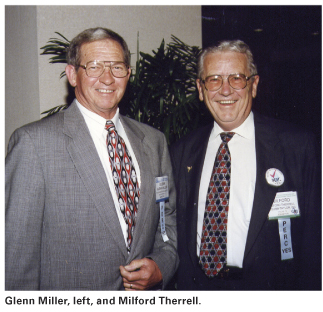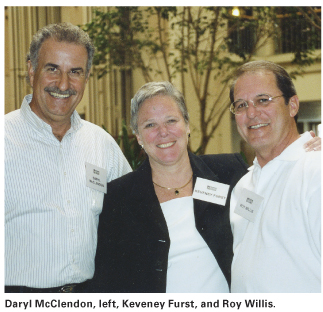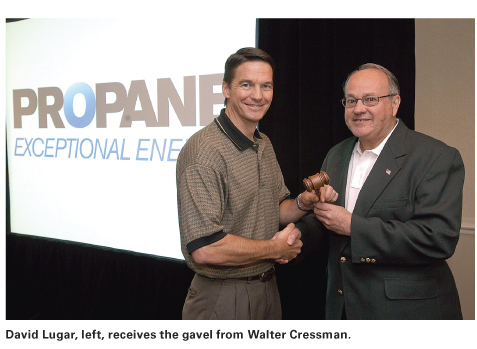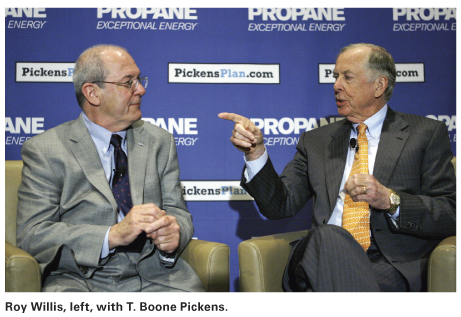
But when PERC president and CEO Roy Willis reflects on the council’s first 20 years, he thinks of all the people who donated their time and energy to enact all those programs since the council’s founding with the Propane Education and Research Act (PERA) in 1996.
“PERC is a unique organization in that it literally is not only funded by the industry but is run by the industry,” explained Willis, who has been with PERC since the council hired him as its first and only president and CEO in 1998. “And almost all of the industry leaders who are engaged with PERC are strictly volunteers who do it on their own dime—they’re not compensated for expenses—and do it to advance the industry. That spirit over the years is really what I think energizes and motivates the work that we do here at PERC, that sense that we’re doing this not only for our company but to advance the entire industry. But when you get down to the programs and projects, faces do come to mind.”
Willis thinks of Milford Therrell, who first proposed the idea to start the council as an industry check-off program and has been called the “father of PERC.” Therrell, who died in 2008, and Glenn Miller of Millers Bottled Gas were early champions of the PERC concept and “wore out miles of shoe leather on Capitol Hill, helping build momentum that ultimately resulted in the law being passed,” Willis noted.


Over the next 20 years, the council went on to contribute to funding and manufacturing of propane-fueled products such as the Bluebird school bus, Roush-Ford F-150 and F-250 trucks, General Motors’ 6.0-liter engine for light- and medium-duty trucks and vans, and agricultural irrigation systems. The administration of the Certified Employee Training Program (CETP) is among its accomplishments in safety and training, and the Energy Guys and the more recent Proudly Propane Clean American Energy campaign featuring Blue the Dog are among the highlights of its consumer education activities. Since PERA was enacted on Oct. 11, 1996, many dedicated propane industry professionals have contributed to the work of those and additional programs.
The Concept
Miller was one of Willis’ earliest mentors when he first started on the council. “He understands what it was like to be an independent propane marketer,” Willis elaborated. “As the council’s first vice chair, he really championed PERC developing serious programs in each one of the functions the law laid out. He obviously wanted to promote propane. So that was a consumer education function, but he also knew safety and training were really important to the industry as well as developing new products.”
Miller recalls how the concept of PERC started to take shape. He had been friends with Therrell for years, and Therrell often mentioned how check-off programs helped organizations such as the National Pork Producers Council and Beef Council raise millions of dollars to promote their industries.
“We were having trouble raising $100,000 over three years” for programs to support the propane industry, Miller remembered. “All the different councils were raising big money, and we couldn’t raise any. Milford said, ‘We ought to try to do that.’ Probably over a drink or two, we decided we were going to try it.”
Therrell and Miller began soliciting help from industry members, including marketers Jimmy Reynolds in Alabama and Harry Lyons in Georgia, who were serving as National Propane Gas Association (NPGA) state directors. Miller recalled that Reynolds played a leading role in helping Alabama become the first state with all of its Congress members signing PERA.
After Therrell and Miller formulated the concept of PERC, finding a bill and a sponsor was their first order of business. At that time, the law firm Patton Boggs was performing some work for the propane industry. Ed Newberry, an attorney at the firm, helped draft PERA—modeled after bills from the beef and cotton councils—and the firm’s lobbyist, Tommy Boggs, was the act’s sponsor.
While the bill was going through the legislative process, the propane industry also had to deal with considerable opposition from the petrochemical industry, which “was afraid they would lose their cheap feedstock, propane,” said Daryl McClendon, who served as president of NPGA, was a founding member of the council, and would eventually serve as the second council chairman. Petrochemical companies “lobbied like crazy against the act being passed,” concerned the propane industry’s marketing efforts would drive up the price of propane and that “they would lose their cheap feedstock, propane,” McClendon added.
But on Sept. 4, 1996, the House passed HR 1514 by voice vote, and the Senate approved the legislation on Sept. 28. President Clinton signed PERA into law on Oct. 11.
The fact that no amendments were attached to the bill helped get it through Congress. “They almost always put an amendment on the bill to ruin it, but we never got tagged with anything. It was strictly a standalone bill,” Miller said. “There was no Democrat or Republican thing. It was just a bill for everybody.”
The new PERA law did not create PERC, however. The propane industry still had to approve it. Propane marketers representing two-thirds of all retail odorized propane gallons sold had to vote in favor of the act for it to become law. Two thirds of propane producers had to agree to it as well.

“So it’s a double super-majority, likely the most difficult bills in the world to have passed,” recalled McClendon. “I don’t know of any other act that required that sort of response, but that was basically what we had to do to convince Congress and the propane industry to go ahead and pass the act.”
McClendon said he spent the entire term of his NPGA presidency traveling around the country, talking to propane marketers and producers about how the act would benefit the propane industry. Eventually, marketers passed the referendum with a 95.5% vote, and producers with a 93.7% vote.
Prior NPGA presidents, including Ralph Rooney, Glenn Saunders, and John Blossman, were involved in communicating the benefits of a “check-off” program to the propane industry. McClendon followed Blossman as NPGA president.
“By the time it got to me, there had been some momentum building for the idea,” McClendon noted. “Each of the preceding presidents contributed to helping move the concept along. People don’t realize how complicated it was to get the act through Congress. When you hear the cliché, ‘It’s like an act of Congress,’ well that’s exactly what it was.”
Early Days
Once the law passed and the propane industry approved the formation of PERC, the work was still just beginning. Industry members had to set up the organization and find people to serve on the council. Therrell was elected to be PERC’s first chair and Miller was elected vice chair.
Jim Ferrell of Ferrellgas chaired a nine-member search committee to begin an exhaustive search for a president and CEO to lead PERC. Over the next several months, a search firm first screened dozens of candidates, then the committee personally interviewed approximately 20 individuals who weren’t already eliminated. The committee ultimately selected Willis, and McClendon concluded “his 20-year tenure and leadership has confirmed that he was the right choice.”
According to Willis, Miller advocated that PERC develop “serious programs” in each of the three functions that PERA laid out: safety and training, research and development, and consumer education. Continuing to talk about the people aspect of PERC, Willis mentioned that Ferrell, who served on the first PERC council, brought a propane-centric corporate perspective to the group. McClendon was the second council chair, and that’s when the consumer education function first kicked into high gear.
Once PERA passed and the propane industry approved the formation of PERC, McClendon and others spent about two years setting up the organization, hiring Willis and other staff members. NPGA and the Gas Processors Association (GPA) nominated the 21 council members, which included nine retail marketers, nine producers, and three at-large members of the public, as PERA required. The assessment to fund the council began on Jan. 1, 1998, at one tenth of a cent per gallon of odorized propane sales.
After becoming chair, McClendon abided by the wishes of many propane marketers to get a national marketing campaign going, and the council hired marketing group Porter Novelli to lead the effort. McClendon asked the marketing group to determine the minimum amount the council would need to spend on a national marketing campaign that was effective and would make a measurable difference in gallon sales. The group ended up with a $50-million overall budget for five years. “Then Porter Novelli made presentations to all of us, and we eventually came up with the Energy Guys,” McClendon reminisced about a campaign that featured an actor as “Propane” and another as “Electricity” in a series of situations where propane proves to be the better energy choice for the most important home tasks. McClendon stated in a 2009 BPN article that the Energy Guys “were a hit from the start. They made a great and lasting, positive impression with consumers and also served to resonate very favorably within the propane industry itself.”
Products…and More People
Continuing to reflect on the people who made PERC programs work, Willis mentioned David Lugar, who was chair of the council at the time of the launch of the Energy Guys campaign. As chair, Lugar created the largest marketing budget in PERC’s history. Lugar was also the first and only member of the council who has served as a marketer member (AmeriGas) and as a producer member (Conoco).

Walter Cressman of Cress Gas, who was the second treasurer of the council and its third chair, was a strong safety advocate and was PERC chair when the council acquired CETP from NPGA. Willis said that was an important milestone that involved digitizing 12 notebooks of training curriculum, “creating e-learning products that today are evolving into online training resources and individual modules that someday a service tech in the field is going to be able to go online and get specific information about an installation they may be working on.”
Willis pointed out that the CETP milestone could not have been achieved without the dedication of the council members and also the PERC Advisory Committee, which has grown from about 30 to 40 people to more than 100 now, “again, doing all this work without any compensation. They do it out of their loyalty and interest in advancing the propane industry.” He appreciates the contributions of John Gawronski, who was the first producer member (Targa Resources) to chair the council and who as chair helped develop the partnership agreement between PERC, NPGA, and GPA.
“You have to talk about Bill Platz, who was chair of PERC during the [U.S. Government Accountability Office] review,” Willis added, noting that Platz was a steady presence in 2009, when the U.S. Department of Commerce (DOC) placed a restriction on PERC’s consumer education activities and the Government Accountability Office conducted a review of PERC activities. The restriction took place after DOC found that the price of propane, compared to other sources of consumer energy, exceeded the threshold established under PERA.
Platz led the council at the beginning of PERC’s efforts to move away from the consumer education focus and toward a commercialization strategy. PERC voted to decrease its assessment rate from five tenths of a cent per gallon of odorized propane sales to four tenths and began looking to invest in working with manufacturing partners to bring propane appliances, equipment, and vehicles to market. Platz got the ball rolling on that strategy change, and Willis said “it sort of went into afterburners” when Joe Armentano of Paraco Gas became council chair in 2012. Under Armentano’s leadership, PERC combined its five advisory committees into one and brought in staff with more commercialization expertise. The council hired former CleanFUEL USA president and COO Tucker Perkins as chief business development officer. Over a five-year period, the council’s investment of $42 million resulted in the creation of 50 different products and 170,000 units sold. “Even at a modest 25 cents/gal. margin, we produced over $1.2 billion in value on that $42-million investment,” Willis explained.
Armentano noted, however, that at the time he took over as PERC chair, the council was not set up to be a technology-oriented organization. He remembers its research and development group was involved in some projects, but “we didn’t have the governance, processes, or structure to ramp up the kind of R&D we really needed to do over the next several years.” After the DOC restriction, the council’s R&D capabilities improved.
“We wanted to make sure, we may be able to get a product, but we have to do our homework upfront to make sure it’s something that could be marketed as well and that there is consumer demand for it,” Armentano maintained, adding that every project included a gallon sales target.
“I think the challenge we faced, and still face today as an organization, is that by nature this industry is not what I would call a sales and marketing industry,” he explained. “The ability to get marketers to embrace technology or other stuff is something PERC needs to do as well. Not just giving it to the marketer, but there has to be training for the marketer to be able to put some of this stuff in place.” He added that PERC’s Marketer Technology and Sales Training (MTST) program is a move in the right direction.

Relationships Lead to Product Development
The relationship between PERC, CleanFUEL USA, and ROUSH CleanTech resulted in an accelerated period of product development during the restriction, with the F-150 and F-250 pickup trucks and Blue Bird school bus as two prominent examples. The period also saw companies with large fleets of vehicles, such as UPS and the Dish Network, adopting propane vehicles. According to Willis, almost no propane school buses were on the road in 2007, but today, more than 7500 are on the road. When PERC started working on propane mowers, no major engine manufacturers were using propane in the off-road market; but now 14 manufacturers offer about 150 different models of propane mowers. PERC funding during the restriction also played a role in the development of the Freightliner S2G propane-fueled bobtail, allowing more propane marketers to “run their fleets on the fuel they sell.”
Products developed during the restriction help propane marketers sell fuel during the non-heating season. “Those programs move along and build both unit volume and propane demand volume over time,” Willis pointed out. “We may invest one or two years in those products, but they’re going to produce demand for the industry for many years beyond the initial research period.” PERC described its work under the restriction as “PERC 2.0,” which resulted in product development that made the consumer education restriction somewhat of a blessing in disguise. “To me it was a good thing in a way, not a good thing that we couldn’t talk to consumers, but having that taken away from us enabled us to really concentrate and develop products that the industry can hook a hose to, products that will continue to produce demand and return to the industry for many years to come.”
NPGA took a leading role in the effort to get the consumer education restriction lifted, and the association achieved that milestone in late 2015. Rick Roldan, president and CEO of NPGA, reflected on PERC’s 20th anniversary by noting that the industry would not be where it is today without PERC’s contributions. At the time of the founding of PERC, creating a check-off program for a fuel had never been done, he added. “Industry leaders came together and stood the organization up where no precedent for one existed. And from day one, PERC has been leading the way with innovative research, product development, and safety initiatives. I’ve had the privilege of watching PERC adapt to not only a changing energy landscape in the United States, but also a whole new marketing environment. The success of the current advertising campaign can be attributed to PERC’s meticulous consumer research combined with new strategies and techniques to reach consumers — ones that didn’t exist the last time the industry embarked on a national advertising campaign. I’m certain PERC will continue to serve the industry well for another 20 years and beyond.”
Future Looks Bright
Soon after the lifting of the DOC consumer education restriction, PERC went to work on developing a new consumer education program. In April of this year, the council unveiled its new program featuring a dog named Blue as the main character of the campaign. Willis believes the new consumer education campaign is a great opportunity for the industry. The start of the latest consumer education campaign comes as the housing market is back on the rise. He added that the industry was fortunate that the restriction took place during a steep decline in housing.
The future looks bright for PERC in other areas. Willis sees an opportunity for the industry to get its entire fleet of vehicles running on propane. PERC is compiling lists of products that operate on propane and will seek to build additional engine platforms that are suitable for propane delivery and service vehicles. “I’m encouraged about that opportunity in autogas and see continued growth potential in that market segment.”
In agriculture, changes in emissions requirements provide an opportunity for propane in products such as irrigation pumps and generators. EPA’s Clean Power Plan provides an opening for propane in power generation in generators and combined heat and power units.
But in the residential market, “We’ve got a fight on our hands,” Willis noted, referring to the expansion of natural gas into traditional rural propane areas. “We’re going to have to be very aggressive in defending our markets as well as making certain we get a larger share of new homes and renovations in those areas of the country that are not served by natural gas utilities.”
Willis sees opportunities for technical innovation in the way that training products are delivered, going from CDs and DVDs to online training products and other items that service technicians in the field could access through their smartphones and tablets.
He hopes that propane marketers, the national and state propane gas associations, and the national and state PERCs collaborate more to make the most of those opportunities. “The great news is we have an abundance of supply in the country. We are now exposed to the global market as we never were before as a propane supplier. But the key to that competition is where is propane most valued. If we can find higher-value use for that propane here in the U.S., it will stay here and be put to use here. The challenge as an industry is making certain that we can create more value for the people who produce and supply the propane, for them to keep it here in the U.S. instead of shipping it overseas.”
Much of that opportunity exists because of the work of Therrell, Miller, and others who were the early advocates of forming PERC as a safety and training, research and development, and consumer education organization. Miller would like to see the work of PERC continue. “I hope people have got enough wisdom since we’ve got it in place to leave it in place,” he stressed. “We always hear people complain but not step up to do something like this. A lot of work went into it. Milford wore out three fax machines; that was the means to communicate at the time. I’m a believer in the political system if you give it a chance to work, but you’ve got to work at it, too. We had a lot of good people join in and help us make it happen.” —Daryl Lubinsky



